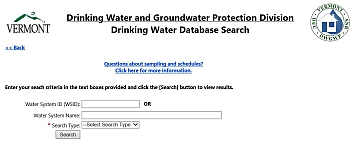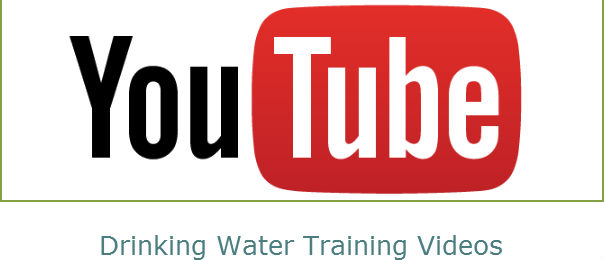Mandatory Electronic Submissions of Reports, Applications, and Forms:
The Department of Environmental Conservation (DEC) is moving toward electronic submissions of reports and other forms. By 2024, DEC will require all submissions to be electronically submitted through our ANR Online Portal.
The Drinking Water and Groundwater Protection Division (DWGPD) is in the process of transitioning its applications into electronic smart forms. Source and Construction Permit Applications can now be filled out completely online:
Public Water System Source Water Permit Application
Public Water System Individual/General Water Main Construction Permit Application
Source and Construction Permit Applications, Bottled Water Applications, Operator Certification Renewal:
To the maximum extent possible, we are asking systems to submit documents and fee payments electronically. Source and Construction Permit applications should be submitted using the links above. For , bottled water documents, and operator certification renewals and payments, you may submit documents and fee payments through our online DWGWPD General Intake Form to expedite their receipt and review. See these Instructions for assistance using the form.
Electronic Submission of Other Documents:
To the maximum extent possible and for the time being, we are asking systems to submit all other documents electronically as well. This includes sampling plan forms, public notice documents, sanitary survey response letters, and water quality results, to name a few. These documents should be emailed to the responsible staff who will process the documents accordingly. For a listing of Division staff and their respective responsibilities, the staff contact information can be found online here. If the attachment is too large for an email, please use our Division File Transfer Protocol portal. The instructions on how to access this portal can be found here. The cover sheet for submissions can be found here.
Important Note: Please follow the below instructions for Surface Water MOR submission via email:
- Send the PDF(s) as an attachment to an email message, to: ANR.DWGWPReports@vermont.gov
- We accept MORs in PDF format -- 1 report (and 1 month and 1 WSID #) per PDF file. (Do not send links to files, Excel docs or Word docs).
- Please use this naming convention in labeling the PDF: WSID number + the month covered by the report + a word or two of the water system name. Example: 30700 Jan Twin Pines (The year of the MOR is not needed in the label)
- Please put WSID numbers (at the least) in subject line of message.
- If you are making a correction to a previously submitted MOR, please indicate that in the PDF’s label.
- If the above is not possible, please use a different method of MOR submittal (i.e., Fax or US Mail).
- To avoid duplication, please do not submit a MOR by more than one method (example: if you submit a MOR by email, please do not also submit that same MOR by US Mail or fax).
Boil Water Notice
- Boil Water Notice Template (non-MCL)
- E. coli MCL template and Instructions
- Boil Water Procedure (Signed April 2024)
Do Not Drink Notice
*NEW* - Public Notice Certification of Delivery (Online Form)
Bulk Hauling
- Bulk Water Hauling Procedure (Signed April 2024)
- *NEW* Bulk Water Hauling Form (Online form)
Water Conservation Notice Template
What to do after a Boil Water or Do Not Drink Notice is lifted
Operations Permit Applications
- Permit to Operate Application for Community Systems, NTNC Systems, and TNC Systems that Require an Individual Permit*
- *NEW* Notice of Intent (NOI) to Operate Subject to the 2020 General Operating Permit *
- *NEW* 2020 General Operating Permit for Class 1A and 1B Public TNC Drinking Water Systems
Operator Certification
- Certified Operator Application (Class 2, 3, 4 & D)
- Certified Operator Renewal Application (Class 2, 3, 4 & D)
- Application for Class 1A/1B Vermont Water System Operator
- Statement regarding Child Support and VT Taxes
Sampling-Based Forms and Applications
- *NEW* - Phase II/V Monitoring Waiver Application (Online Form)
- Lead and Copper Rule
- Corrosion Control Treatment (CCT) Recommendation Guidance including CCT Recommendation Form (PDF)
- *NEW* Corrosion Control Treatment Recommendation Form and Guidance (Online Form)
- Lead public education template (“Important Information About Lead in Your Drinking Water”)
- *NEW* Consumer Notice of Lead Tap Monitoring Results Certification (Online Form)
- Consumer Notice of Lead Tap Monitoring Results Certification (PDF)
- *NEW* Lead and Copper Sampling Plan (Online Form)
- Lead and Copper Sampling Plan (PDF)
- Lead and Copper Sampling Plan Guidance
- Alternate Lead and Copper Monitoring Schedule Application (Online Form)
- Alternate Lead and Copper Monitoring Schedule Application (PDF)
- Lead and Copper Rule Revisions
- Revised Total Coliform Rule (RTCR)
- RTCR Coliform Sampling Plan & Guidance 1,000 or Under Population
- RCTR Coliform Sampling Plan & Guidance Greater than 1,000 Population
- Groundwater Seasonal Start-Up Form
- Surface Water Seasonal Start-Up Form
- RTCR Level 1 Assessment Form (PDF)
- Disinfection By-products (DBPs)
- DBP Sampling Form (Online Form)
- DBP Sampling Form (PDF)
- *NEW*- Operational Evaluation Report (Online Form)
- LT2 Sampling Plan Form
Administrative Forms
- Water System Officials Contact Form
- Consecutive System Exemption Application
- Public Water Supply Survey Form
- *NEW* - Public Notice Certification of Delivery (Online Form)
- *NEW* - Consumer Confidence Report (CCR) Certificate (Online Form)
- Public Notice Certification Form - (old form PDF)
- Fillable Bulk Water Hauling Form -(old form PDF)
- Fillable Extended-Period Bulk Hauling Form -(old form PDF)
Operating Reports
- Monthly Operations Report for Filtered Surface Water Systems
- Instructions for Monthly Operations Report for Filtered Surface Water Systems
- Monthly Operations Report for Groundwater and Systems Purchasing Water
Construction Permits
- Construction Permit Application*
- Construction Permit Application Guidance Document
- Evaluating Water System Hydraulics
Source Permit/Source Documents
- Source Water Permit Application Process Overview (Read first)
- Source Water Permit Applications
- Source Testing Review Application*
- Groundwater Withdrawal Application*
- Well ID Sheets
- Avoidance of Filtration for Surface Water and GWUDI of Surface Water
- Certification of Water Source Likely Affected by Agricultural Lands
- GWUDI Exemption
- GWUDI Exemption Application
- Guidance
- Laboratories performing Microscopic Particulate Analysis (MPA) Testing
- Source Water Protection "How To"
- Checklist for Completing a Source Water Protection Plan
Operation and Maintenance Manuals
Long Range Plan Templates
- Long Range Plan Template for Community Water Systems
- Long Range Plan Template for NTNC Water Systems
*Note: Please be aware that other VT Agency of Natural Resources (ANR) permits may be needed for your project and it is your responsibility to secure any other required permits. To help assist in determining whether other VT ANR permits that might be needed, ANR recommends that you use VT ANR’s Permit Navigator Tool by going to the VT Department of Environmental Conservation website (dec.vermont.gov). In addition, please be aware that your project may require other local, state, or federal permits outside of VT ANR’s jurisdiction which are not covered by the VT ANR Permit Navigator Tool. Failure to secure all necessary permits in advance of construction can result in significant impacts to your project’s final scope and can take additional processing time*
File Transfer Protocol (FTP) Instructions and Cover Sheet NEW


